Shimadzu’s STEAM Education Support Fostered by the Spirit of “Science is Practical Knowledge"

“Science is practical knowledge. Knowing only theory is meaningless if it doesn't serve people's needs.” These are the words spoken by Shimadzu’s first president, Genzo Shimadzu Jr., to his employees at the time. Now, more than 100 years later, STEAM education, a form of interdisciplinary education that makes use of learning to discover and resolve the issues facing society, has spread globally.
STEAM Education
STEAM was coined from the first letters of science, technology, engineering, art, and mathematics. This form of education aims to foster human resources capable of making a practical difference by understanding these subjects from an interdisciplinary perspective, relating them to society to discover issues, and finding ways to resolve these issues through creative thinking.
In the modern era, the approach of STEAM education, which is becoming a focus of attention as a necessary skill, is similar to the approach of Genzo Shimadzu Jr., who described science as a practical knowledge in the early 1900s.
Shimadzu Hands-On Analysis School, Now in its 17th Year
From the perspective of wishing to create opportunities for children to gain an interest in science, Shimadzu Corporation has held the Shimadzu Hands-On Analysis School for children for the past 17 years. Courses have been developed at levels suitable for elementary, junior high, and senior high school students, and events are held at the Head Office in Kyoto and various Japanese locations during the summer vacation. To date, more than 9,000 people have participated.
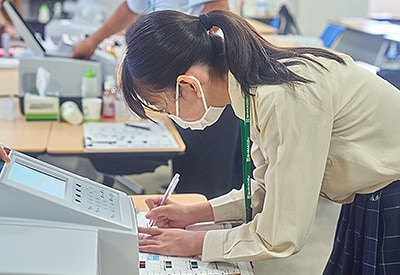

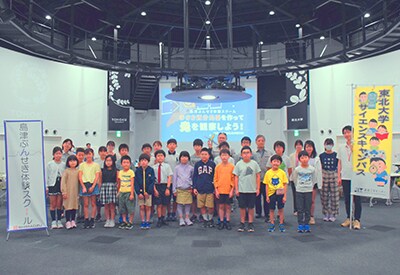

The Author Participated in the Course Aimed at Senior High School Students
Normally, the Shimadzu Hands-On Analysis School is only open to children. However, the chromatography course was held as an in-house study session for employees, so the author (from the Corporate Communication Department) participated. Here, the author's subjective experiences will be shared in this report.
Event Report (1) Employees from a Variety of Occupations Participated
A high-performance liquid chromatograph (HPLC), one of Shimadzu’s flagship products, was used for the chromatography course. This instrument analyzes samples to investigate what components they contain, and in what amounts. In this particular course, it was used to investigate the amount of caffeine contained in beverages.
New recruits participated in the in-house study session, as did employees with a variety of backgrounds including people from administrative departments, production facilities, and Shimadzu Group companies. Employees from Shimadzu Techno-Research, Inc., a Group company responsible for contract analysis, served as the instructors.

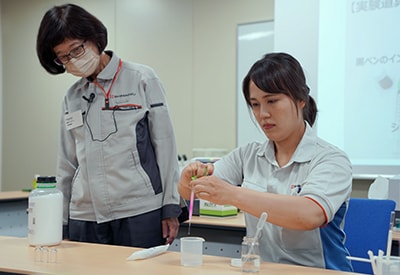
Instructors from Shimadzu Techno-Research, Inc.
Event Report (2) Understanding the Basic Principles of Chromatography

Firstly, experiments were performed to understand the basic principles of the instrument. Using a syringe, ink from a black ballpoint pen was extracted from a small bottle. It was inserted into a Pasteur pipette filled with silica gel. This was very exciting from the author’s point of view.
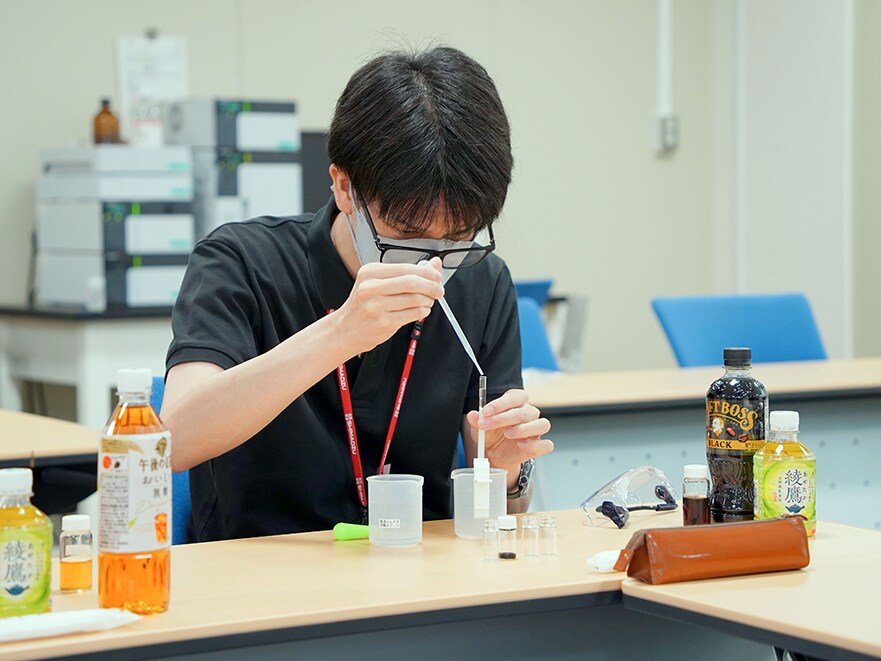
Participant taking part earnestly in the course
When the Pasteur pipette was flushed with water, the black ink separated into a rainbow of colors including purple, blue, green, and orange. All the participants learned so much from the instructor’s explanation: “It was separated into one different color after another. Chromatography means to draw colors in Greek.”
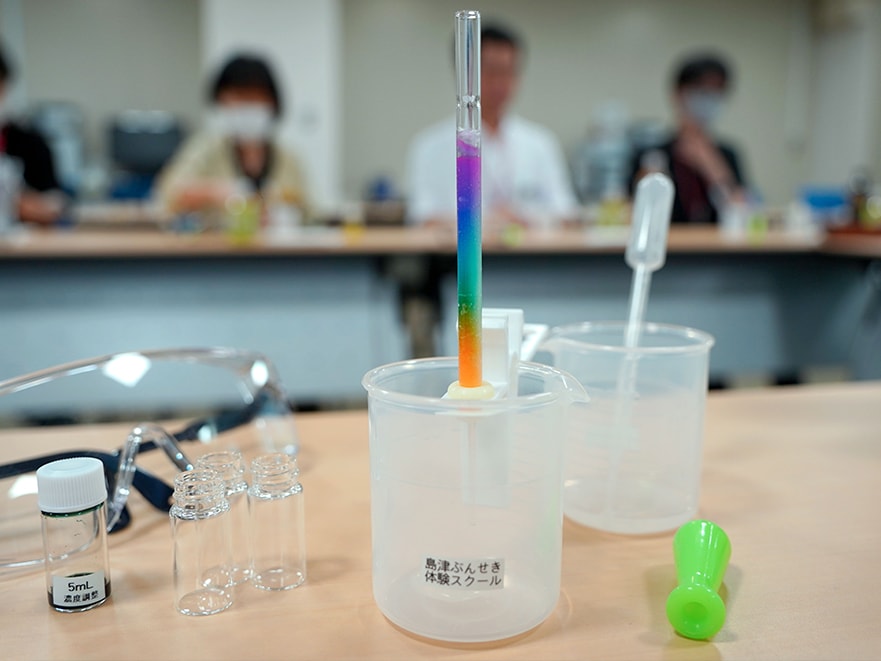
Event Report (3) Finally Performing Analysis Using the Instrument!
Having grasped the basic principles of the instrument, we proceeded to actually measure the amount of caffeine contained in commercially available beverages using HPLC. We began by first pretreating the samples.

The samples were passed through a fine filter. It is necessary to remove even fine particles too small to be seen by the naked eye.
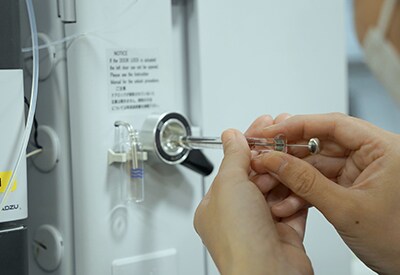
Analysis using HPLC. The participants worked carefully, because the needle was delicate, and easy to inadvertently bend.
Measurement was completed about 5 minutes after starting, and the peaks were shown on the display. When these results were converted to indicate the amount of caffeine contained in the applicable beverages, the participants were surprised to learn that some of the beverages contained unexpectedly high levels of caffeine, while other beverages contained none at all.
At the end of the course, the instructor explained that HPLC is utilized in a wide range of fields for quality control and research and development related to food products and pharmaceuticals. In keeping with the expression “seeing is believing,” I was able to increase the extent of my understanding of this topic through participation in the chromatography course.
A School Participant is Recruited by Shimadzu!
One of the children who participated in the Shimadzu Hands-On Analysis School as an elementary school student eventually joined Shimadzu as an employee. Her name is Marina Fukui. She joined Shimadzu in 2020, and works in a department involved in the development of gas chromatograph mass spectrometers (GCMS), one of Shimadzu’s flagship products.
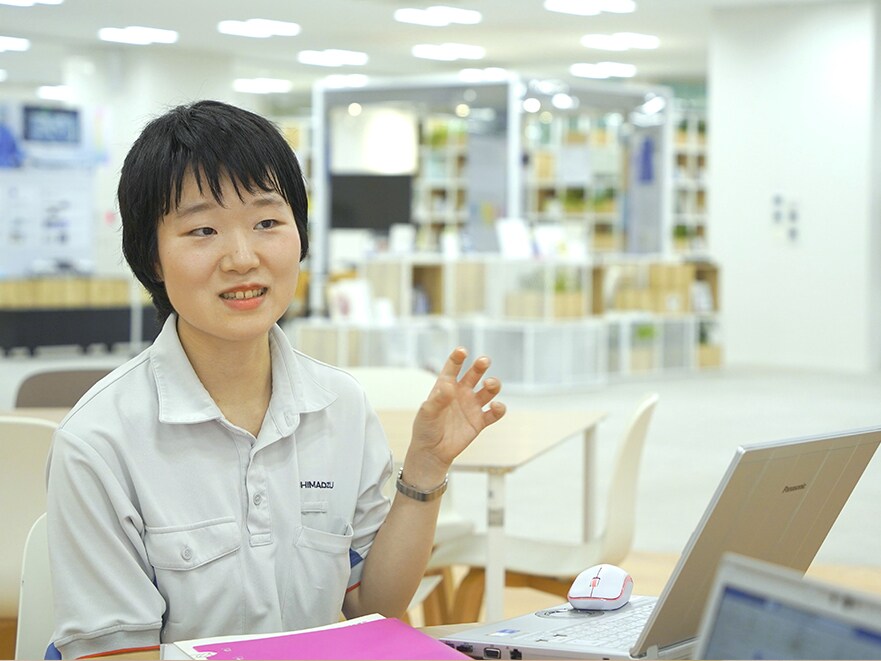
“On the recommendation of my parents, I participated in a course in which I built a spectroscope out of cardboard, and used it to observe a light source. I first became aware of how interesting experiments can be through the experience of seeing something that I previously could not, using something that I built myself. From that point, science experiments became my favorite subject at school. After I started studying math in junior high school, I came to realize that everything in our everyday life can be represented mathematically, and I made the decision to study science.”
At university, she studied electric/electronic engineering, and became affiliated with a laboratory involved with ultrasonic waves. “Through research, if you apply your knowledge, you can create products that are useful in everyday life. It was something that even I could probably do, and I decided on that sort of work.”

In front of the laboratory at the Healthcare R&D Center where she normally works
One of the reasons that Fukui, who had not been familiar with Shimadzu instruments, decided to join Shimadzu was reading ”A record of two Shimadzu generations, father and son -A trajectory of trust and passion” (link to the Japanese website), a comic describing the founding and development of Shimadzu Corporation. She was particularly struck by the words of Genzo Shimadzu Jr., “If you learn a scientific principle, you must also consider its applications. Learning should be practical.” She selected Shimadzu as the stage from which to serve the world at large using her studies, and to challenge herself to come up with something new. Now, Fukui is involved in the development of GCMS instruments.
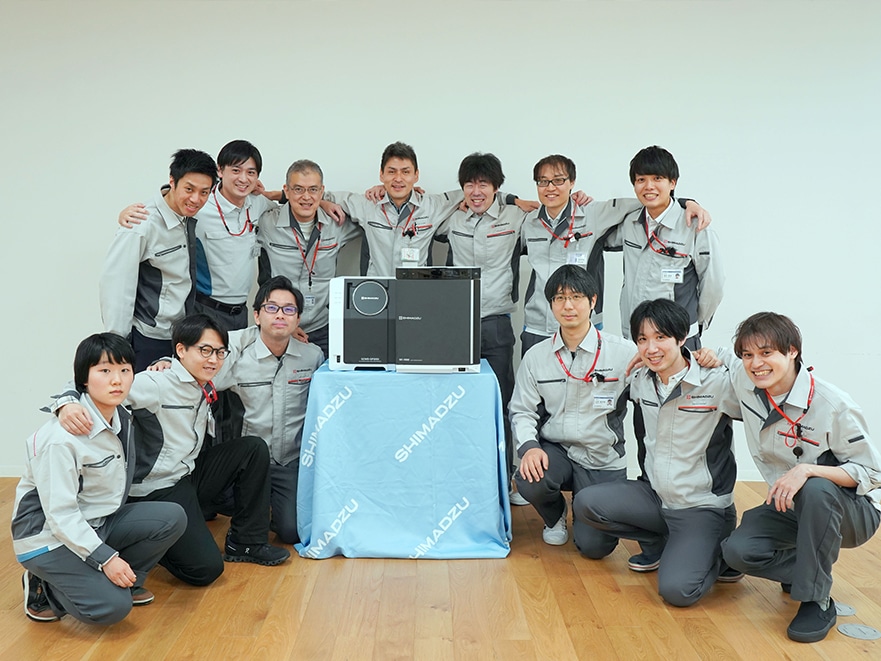
Member of the development team for the GCMS-QP2050 (at the center of the photo), one of the industry’s smallest gas chromatograph mass spectrometers.
Marina Fukui is on the far left in the front row.
Comments from the Person in Charge of the Shimadzu Hands-On Analysis School
We have continued to improve the content through cooperation with the engineers who served as instructors. In particular, we have found ways to make understanding the basic principles of analytical instruments, which are very hard for children, more enjoyable, and to ensure that they grasp the significance of the instruments.
In continuing our activities, we received comments from in-house that employees wanted a chance to try out the Shimadzu products with which they are always involved. As a result, we now hold courses for Group employees as well. More and more of the employees who have participated become school instructors or undertake volunteer activities, thereby expanding the reach of science, which I am happy to see.
We will continue to work to ensure that children gain an appreciation for science, and come to realize that studying serves a useful role in society.
 Page Title and URL Copied.
Page Title and URL Copied.


